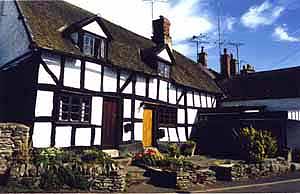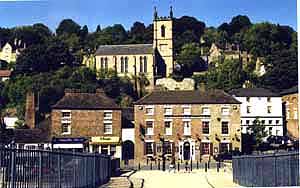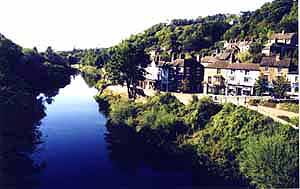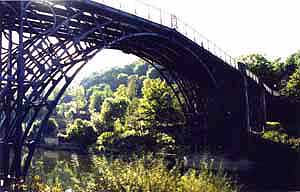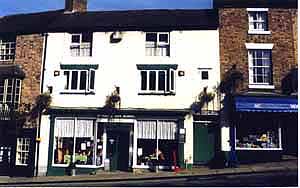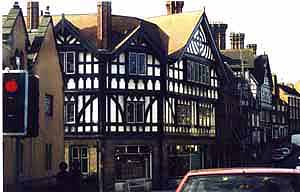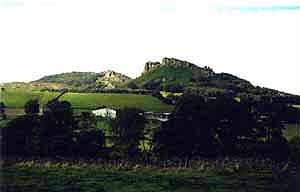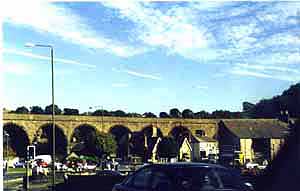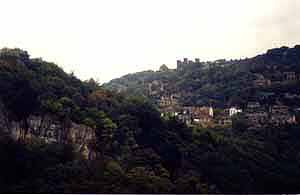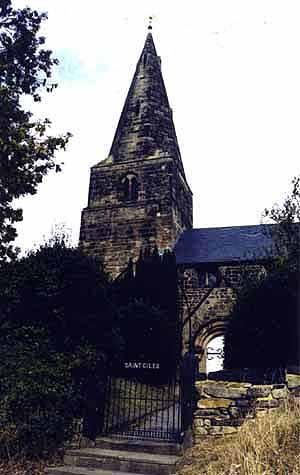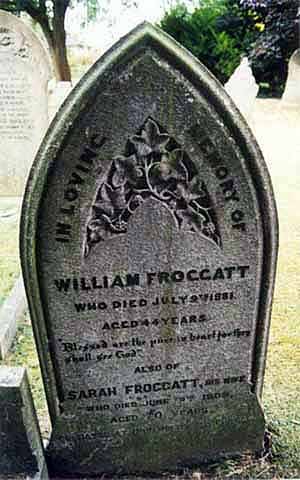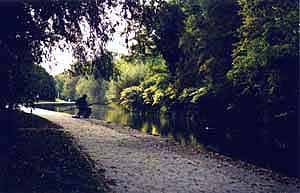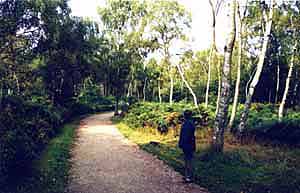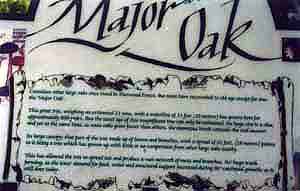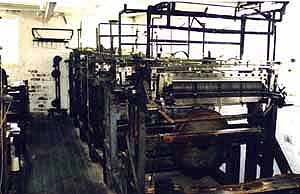WEEK 2DAY 8Hay-on-WyeWeek 2 started with breakfast at the B&B in Brecon, then we headed northeast to Hay-on-Wye, the bookshop capital of the world. For some strange reason, this village specialises in second hand bookshops and those books not wanted by the shops are staked in neat rows under cover in the grounds of the local church. You could spend weeks looking through all the shelves of books, but we did not have that amount of time and contented ourselves with a few specialist book shops. Black and White HighwayThen on to Herefordshire and the Black and White Highway. This is a trail of small villages that are dominated by the traditional black and white houses. We picked up a helpful brochure from the Visitor's Centre at Hay-on Wye that shows the best route to take and give details of the villages. [Update 2009 - this B&W trail is now largely defunct, although the villages and houses are still there. The villages have obviously suffered from the economic decline, many of the shops are shut and the villages are looking unkempt. The cider factory has closed.]
Broseley Pipeworks & Iron Bridge Gorge MuseumsFrom Pembridge we headed north to Shrewsbury then to the heart of the Industrial Revolution - the Iron Bridge Gorge Museums. Our first stop, partly by accident as we misread the map, was the village of Broseley and the Pipe Works. At first glance of the direction signs, I thought this was to be a clay pipe works, as in clay drainage pipes, but no, these were tobacco pipes and regarded as the best in the world. The last factory closed in 1957 and is now open as one of the Iron Bridge Gorge Museums. There are several good websites on the pipeworks (more info...) From Broseley we headed towards the famous Iron Bridge. It was now mid-afternoon on a clear fine day and the blue sky was reflected in the calm waters of the Severn River. The crowds of people were starting to fade away and we were able to look closely at the bridge and village. We then planned to head towards Telford and find a B&B or pub for the evening. This was Monday and we reasoned that accommodation would not be too difficult - and we could not be more wrong. Everywhere we tried was full. At Telford they suggested we head east a bit as there were some nice rural pubs - all full. Lichfield - full. Finally, a hotel offered to ring Derby for us and found a room in the Royal Stuart in Derby. That sounded nice, but when we arrived at 9pm we found the hotel in the midst of extensive renovations - and our room was long overdue for a major refit. DAY 9We woke early in our dingy room in Derby and were so despondent about the price we paid for such a terrible room that we did not even stay for breakfast, fearing that it would be as bad as the room. So we headed back down the A38 then west on the M54 to continue our exploration of Iron Bridge. The day was again bright and sun-filled and a good breakfast was wonderfully cheering. We then headed for Blists Hill and the Victorian Town - a wonderful working museum of Victorian industrial life. On the village coomon were gypsy caravans and sideshows and I was talked into trying my hand at the old classic - the coconut shy. I had been known to succeed at this game 20...30... actually 40 years ago so I took up the wooden balls, picked a good coconut and threw - and once again missed by miles. Undaunted, I threw again, and sure enough a coconut fell to the ground, just as it had 40 years ago. Two more balls to go.... we kept one coconut, gave one back the operator and gave the third away. My aim definitely got better with age. WedgwoodMid-morning we headed to Stoke-on-Trent, trying to decide which of the potteries we would visit. The first sign we saw was Wedgwood, so that was decided and we arrived at the Wedgewood Visitors Centre not quite sure what to expect. We found a wonderful new Centre full of information, audiovisual history and guided tours on the hour. We decided to book a tour and then found that the main factory was being renovated and was closed, "..so you will be able to tour Coalport instead". We had to admit that although we knew a lot about Wedgwood, it was based on examples seen 12,000 miles away and Coalport was not well known to us. We had a late lunch at the Wedgwood Ivy House Restaurant, that was clearly designed to cater for many bus loads of people at once, then out we went to Coalport. All was revealed - Coalport is the figurine factory and we were able to watch, fascinated, as various body parts were created, dried, fired, assembled, fired and finally hand painted into the most delicate figures. It was a fascinating hour.
But time was pressing so we headed north through Leek, Buxton, Chapel-en-le Frith, Hayfield and Glossop, then over Snake Pass and down into the Derwent Valley. These were all towns we knew the names of from hours of family history research, and towns we will have to come back to and spend time in.
Lady Bower ReservoirThe upper part of the Derwent is dominated by the Lady Bower Reservoir and we found it calm and mirror-like in the late afternoon sun. But no time to explore, we were close to the village that had such a fascinating name - FROGGATT
Froggatt VillageFroggatt Village is a small knot of houses beside Froggatt Wood, nestled beside the Derwent River and below the imposing skyline of Froggatt Edge. It is an ancient town, and the name dates back hundreds of years.
Chequers Inn at Froggatt EdgeAbove the village the A625 runs south from Sheffield and drops off the high Edge into the Derwent valley. Part way down is the old Chequers Inn, where we planned to stay for 3 nights. The Inn is a wonderful old building, well maintained and with rooms, food and beer of high standard. We thoroughly enjoyed our stay at the Chequers Inn and recommend it to any traveller.
Froggatt WoodFroggatt village today is surrounded by forest, managed by the National Trust. Much of this forest was farmland gifted to the NT and has reverted to forest.
Not long after we returned home I was sent a newspaper clipping from a colleague who had just arrived at Sheffield University:
Castleton and Blue John CavernWe headed back north to Castleton looking for the caverns from which Blue John (fluorite) was mined. We had decided from scanning the websites that Treak Cliff Cavern would be the most interesting tour so we arrived early (as usual) and headed up the steep path to the cavern entrance. The first tour was not until after 10am and the ticket office only opened just as the tours began, so we waited with a group of other tourists. Shortly we saw a coach pull up on the road below and disgorge a large school group who headed up the hill and flooded the waiting area. Soon another coach did the same, then a third, and we were drowned in young teenagers. Our waiting group asked if the school party was to have their own tour, and when the answer was "NO!" we all left and headed for the Blue John Cavern at the top of the hill. We were well pleased with that decision and thoroughly enjoyed our small group tour of the Cavern.
A stroll along Froggatt EdgeAbove the village of Froggatt, the skyline is dominated by the sharp outline of the gritstone cliffs of Curbar and Froggatt Edges. After spending the morning underground in Blue John Cavern, we took advance of the perfect weather to walk along the Edge. We parked the car in the park just above Curbar and below the Edge, then walked up onto the gritstone rocks. It was a fascinating afternoon with a magnificent view of the Derwent Valley.
After retracing our path back to Curbar Gap, we headed south along Curbar Edge to Wellington Monument - a fitting place as we live in Wellington, New Zealand.
After such a long walk we headed back to the Chequers Inn for a well deserved pint, or two, and a delicious evening meal. The Froggatt family were well satisfied with their day in Froggatt. DAY 11Today we were set to explore the southeastern part of Derbyshire. We started with the Wind in the Willows Museum at Rowsley and followed the story of the river-bank friends, all faithfully recreated and is well worth the visit for anybody who has read the story, based on Kenneth Graham's observations of river life in Derbyshire. The museum has now been relocated to Henley on Thames.
Next was Matlock Bath and the Heights of Abraham, taking the cable car to the top. Patches of low cloud obscured some of the view, but still well worth the visit. From Matlock we toured through villages with Froggatt family connections - Matlock, Cromford, Wirksworth, Ashbourne, Clifton, Mayfield and finally back to Froggatt for another pint and meal. DAY 12SandiacreDeparted Chequers Inn and headed south towards Derby then to Sandiacre on the Derby/Nottingham border, where my grandfather was born. His father and 3 of his siblings reside in the churchyard of St Giles at Sandiacre, so we found the church and the graves. A few days later we visited the grave of William's parents and some of his siblings at Nottingham General Cemetery.
Nottingham and Brewhouse YardOn to Nottingham and other family locations. First stop was Brewhouse Yard under the Castle, where we had lunch in the wonderful old pub - Ye Olde Trip to Jerusalem. The pub is reputed to be the oldest in Britain, and it was easy, sitting on the old wooden seats, leaning on the worn counter or ducking under the low door frames to imagine my great-great-grandfather and great-grandfather sitting right there drinking and eating. Adjacent is the Brewhouse Yard Museum of Victorian Nottingham life. Five generations of Froggatts were associated with Brewhouse Yard, beginning in 1801 so the location held considerable family interest. The building leased by the Froggatts at BHY and owned by Cornelius Launder was demolished early in the twentieth Century and has been replaced by lawn and open space in front of the Museum. The family moved from BHY to Castle Wharf, built on the Nottingham Canal nearby and from there to The Park. Castle Wharf today has been redeveloped into apartments.
From BHY we walked up to the Castle and met a local who ran small coach tours around Nottingham, so off we went. First stop was The Park - the residential area beside the Castle, which I had read about as my great-grandfather had lived and been married there. Only later did I manage to discover which house he had lived in. We travelled around the centre of Nottingham, through the Lace Market area, and this gave us a good overview of the city. DAY 13Nottingham TownSaturday was our chance to explore the centre of Nottingham, the old town market square and to find the Library that had Internet access. After 2 weeks away we were conscious that the email pile might be too large to ever deal with, so an hour on the computers fixed that. Walked the shops, the lanes and the gates, all place names well known in the family history. Lunch was an experience of cornish pasties at the specialist shop of the corner of the market. Nottingham General CemeteryEverybody with an interest in their family history in Notingham eventually ends up at the Nottingham General Cemetery. It is a large plot and hold thousands of burials. Somewhere here was a Froggatt grave with 2 adults and 4 of their children. The cemetery starts on a crest and drops quite steeply in parts into a broad valley. We searched systematically from the bottom to the top - well as regularly as you can with graves that climb up the hillside. After nearly an hour of searching, interspersed with trying to creep up on squirrels for a good photo (that was a failure) we found it. Close to the main gate, but dropping down off the main path. A low lying headstone rather than the more obvious upright slate ones. But none-the-less an important part of history with names and dates recorded. DAY 14Sherwood ForestNottingham and Sherwood Forest are synonymous, so any visit to the area must include the famous forest. Again we arrived early, before the crowds and had our pick of the car park and the excellent displays in the Visitor Centre. A short walk through the forest brought us to the Major Oak, the largest oak tree in the forest, now propped up by poles and scaffolding, but still a large tree.
Ruddington Framework Knitters MuseumSouth of Nottingham lies Ruddington with its well known Knitting Museum. The guidebooks say the museum is open from 11am on Sundays so we headed straight there from Sherwood Forest. Our interest in frame work knitting stems from a comment in the Will of James Froggatt (died 1808) who left seven stocking frames to his wife. What did these frames look like? We found the Museum down a small path, but the sign was definite - Open 1pm Sunday. What to do for an hour? Lunch at the local pub of course. There are 2 pubs in Ruddington, adjacent to each other as is often the case. Only one advertised lunches so in we went. Yes - Sunday Roasts are available, would you like beef, pork or chicken? You get a selection of vegetables with that - yes you can choose. So 2 beef and 1 pork were ordered, plus beer and 2 ciders and down we sat presuming we would get a bowl of vegetables from which we could choose. Shortly the meals arrived - extra-large plates heaped with tender roast meat, about 8 varieties of vegetable including potatoes cooked three ways (roast, boiled, mashed) and large jug of gravy. A massive meal that we had to do justice to - leaving only splatters of gravy on the plates. We then waddled back to the Knitting Museum that was now open, wondering how we would manage to climb the stairs, but we did and had a fascinating hour reliving the lives of the framework knitters. The machines in the museum are still in working order, so you watch as lace grows off the machine. But be warned - the machines make a terrible noise, and the din in the room when a large number were operating would best be guessed at. Loss of hearing is not something widely reported in family histories, and is not usually fatal, but I would not be surprised if many of our framework knitting ancestors were deaf.
Last updated: 15/06/2017 |
